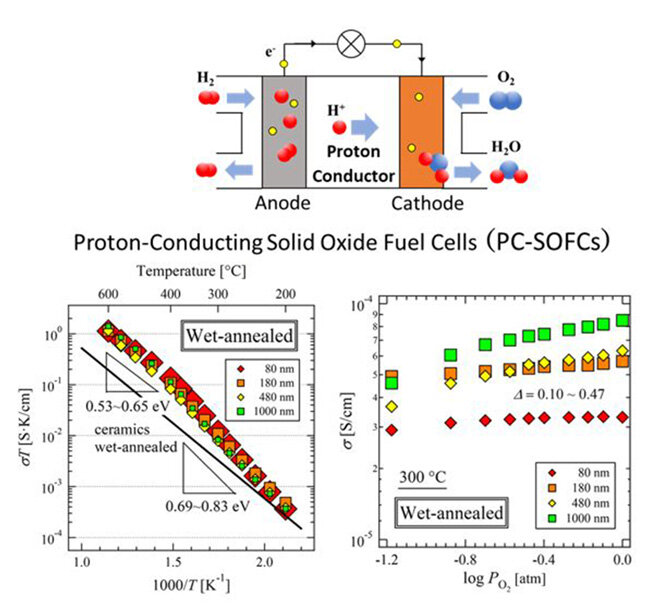2024.06.20 Thursday
Towards Cleaner Energy: Breakthrough in Anode Electrode Materials for Proton Conducting Solid Oxide Fuel Cells Operating at Medium Temperature
Researchers unveil a new perovskite-based anode material with mixed hole-proton conduction to achieve high efficiency at low and medium temperatures

Amidst the ongoing energy and climate crises, the stakes have never been higher. We are pressed for time to find better ways of producing clean energy to replace fossil fuels. Thus far, fuel cells appear to be one of the most promising research directions. These electrochemical devices can produce electricity directly from chemical reactions, which can be tailored to be environmentally friendly in terms of their reactants and outputs.
Various types of fuel cells exist, but solid oxide fuel cells (SOFCs) have attracted special attention from researchers. By operating without the need for a liquid electrolyte, they offer higher safety and are often easier to manufacture. Unfortunately, one of their main drawbacks is their high operating temperature. Conventional SOFCs need to be at over 700 °C to work properly, which limits their applicability, reduces their efficiency and power output, and often compromises their durability. Thus, proton-conducting SOFCs (PC-SOFCs), which can operate within a lower temperature range, are being investigated as a promising alternative.
Against this backdrop, a research team including Professor Tohru Higuchi from Tokyo University of Science has achieved a breakthrough in PC-SOFCs by developing a novel hole-proton mixed-conductor material. Their findings, which have been published in the Journal of the Physical Society of Japan on June 18, 2024, could pave the way for important technological advancements in energy technologies.
The material in question is a perovskite-type oxide ceramic with the formula BaCe0.4Pr0.4Y0.2O3−δ (BCPY). These particular dopants, namely Pr and Y ions, were selected based on previous works by members of the research team. They observed that BaCe0.9Y0.1O3−δ and BaPrO3−δ exhibited proton and hole (a type of positive charge carrier) conduction, respectively. Thus, they theorized that co-doping with both Pr and Y might lead to high proton-hole mixed conductivity.
Such a material could be used in the anode electrode of PC-SOFCs, as Prof. Higuchi explains: "The Pt metal electrode used in other fuel cells has issues, such as a large drop in power output because electrochemical reactions occur only at the three-phase interface where the fuel gas/electrode/electrolyte intersect. To solve this issue, a dense membrane with mixed conduction could be useful for improving the performance of PC-SOFC by expanding the electrochemical reaction area."
Using a sputtering technique, the researchers produced thin films of BCPY and carefully analyzed its conduction properties, seeking to find evidence of mixed proton-hole conduction. To this end, they established a quantitative evaluation method to determine oxygen vacancies using X-ray absorption spectroscopy and defect chemistry analysis. Through these and several additional experiments, including synchrotron radiation photoelectron spectroscopy for electronic band structure analysis, they found substantial evidence that mixed hole-proton conductivity can occur on the surface of the proposed electrode material.
Notably, BCPY electrodes exhibited a high conductivity of over 10−2 S.K/cm at 300 °C, which outlines a bright future not only for PC-SOFCs, but for other technologies as well. "If we can further confirm that BCPY thin films do enable hole-proton mixed conductivity, BCPY may become a novel oxide material for not only PC-SOFC anode electrode membranes but also electric-double-layer-transistors," highlights Prof. Higuchi. To clarify, this transistor technology can address the scalability and miniaturization problems of conventional transistors, which will be crucial to developing artificial intelligence systems and increasing the computational capacity of personal electronic devices.
In any case, this study sheds some much-needed light on new electrode materials for PC-SOFCs. With further advances in this exciting field, electrochemical energy generation could eventually enable us to power up our homes and cars with cleaner electricity, paving the way to more sustainable societies.

Image title: Proton-conducting solid oxide fuel cell (PC-SOFC)
Image caption: (Top) Schematic diagram of a PC-SOFC; (Bottom left) Arrhenius plot and activation energy of BCPY thin film on the anode side; and (Bottom right) Conductivity of BCPY thin films as a function of oxygen partial pressure.
Image credit: Tohru Higuchi from TUS
License type: Original content
Usage restrictions: Cannot be used without permission
Reference
| Title of original paper | : | Surface Hole-Proton Mixed Conduction of BaCe0.4Pr0.4Y0.2O3-δ Thin Film with Large Amounts of Oxygen Vacancies |
| Journal | : | Journal of the Physical Society of Japan |
| DOI | : | 10.7566/JPSJ.93.074706 |
About The Tokyo University of Science
Tokyo University of Science (TUS) is a well-known and respected university, and the largest science-specialized private research university in Japan, with four campuses in central Tokyo and its suburbs and in Hokkaido. Established in 1881, the university has continually contributed to Japan's development in science through inculcating the love for science in researchers, technicians, and educators.
With a mission of "Creating science and technology for the harmonious development of nature, human beings, and society," TUS has undertaken a wide range of research from basic to applied science. TUS has embraced a multidisciplinary approach to research and undertaken intensive study in some of today's most vital fields. TUS is a meritocracy where the best in science is recognized and nurtured. It is the only private university in Japan that has produced a Nobel Prize winner and the only private university in Asia to produce Nobel Prize winners within the natural sciences field.
■
Tokyo University of Science(About TUS)

About Professor Tohru Higuchi
from Tokyo University of Science
Tohru Higuchi is a member of the Department of Applied Physics at Tokyo University of Science. He received his bachelor's degree in Applied Physics from Tokyo University of Science in 1995, where he later earned his master's and PhD. His research focuses on functional material science, with a particular emphasis on thin-film/surface and interfacial physical characteristics, as well as inorganic industrial materials. He has published over 200 articles and earned several honors, including those for his contributions to the GREEN-2019 conference and the 2019 International Symposium on Advanced Material Research.
Laboratory website 
Official TUS website 
Funding information
This work was partially supported by a Grant-in-Aid for Scientific Research (22K04933) from the Japan Society for the Promotion of Science (JSPS), and JST Establishment of University Fellowships towards the Creation of Science Technology Innovation Grant Number JPMJFS2144.

